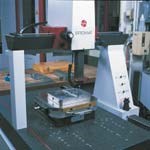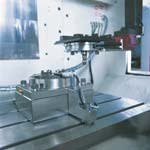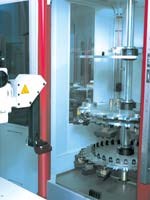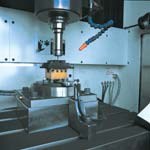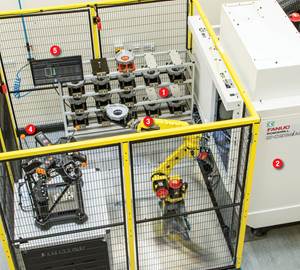On The Path To Automation
Implementing an integrated tooling system proved to be this mold shop's first step toward automated operation of its electrical discharge machines and graphite mills. Today, the shop's robotic cells can run around the clock in an unattended mode.
Share


Automation doesn't have to happen all at once. It is achieved in degrees, one step at a time. For that matter, the move to automation is never complete; there is no such thing as a 100-percent automated shop. Every shop, however, has to have a starting point.
For Matrix Tooling, Inc., in Wood Dale, Illinois, the place to start appeared naturally, when it acquired a ram EDM (electrical discharge machine) equipped with an integrated tooling system. Installing the same system on an existing VMC for electrode milling was the next step. The shop was now on a path that would eventually lead it to install several robotic cells capable of round-the-clock unattended operation. Along the way, the entire shop had to change its approach to job planning on the shop floor and make other adjustments. This transition has been essential to making the shop a competitive supplier to customers on a worldwide basis.
Getting Started
Matrix was founded in 1978 by the Ziegenhorn family. Today, brothers Paul, Jim, Mark and Tom, along with John Sauber, vice-president and general manager, share the responsibilities of running the operation that consists of the design and contract manufacturing of multi-cavity injection molds. With their newly expanded facility of 30,000 square feet, Matrix has branched into plastic injection molding as well. In recent years, the company achieved ISO 9001 certification. Matrix now provides a full set of services including mold design, mold building and qualification of molds and plastic molded parts.
"Most of our markets," says Mr. Sauber, "are comprised of multi-cavity molds for a variety of consumer goods, electronic, medical and automotive products. We've truly become a global supplier," he continues, "with a significant amount of our molds being shipped not only to our U.S. customers, but also to their other manufacturing facilities including Mexico and the Pacific Rim." This globalization, coupled with customer needs, has driven Matrix's business. Superior consistency across entire sets of molds is critical, as parts from the Matrix molds are sent from facilities all over the world for final assembly.
Matrix, like many successful mold shops, has discovered that integrating engineering and manufacturing technologies is essential to maintaining quality while reducing product cycle times. "In the last few years," Mr. Sauber says, "we've seen production times for a typical multi-cavity mold reduced from, say, 12 weeks to 8 and sometimes even as few as 6 weeks. What we did 5 years ago and what we do today, as far as precision and repeatability is concerned, has dramatically increased.
To meet this challenge, Matrix has moved to integrated design and manufacturing software. By doing the mold design and manufacturing programming on the same system, there is no need to translate data on the shop floor. Once approved, the 3D solids of the cavities and cores and electrodes are delivered directly to machining centers for graphite production and CNC ram EDM.
On the shop floor, Matrix quickly discovered the benefits of palletizing with an integrated tooling system (ITS). The ability to move a block from one machine to another without having to relocate the workpiece has resulted in greater use of machine spindle time.
Matrix's first experience with integrated tooling was in 1991. At that time, a new Makino EDM came outfitted with integrated tooling on the machine head. This system, from Erowa (Arlington Heights, Illinois), was also installed on an existing VMC used for milling graphite electrodes. "We were cutting one electrode at a time," recalls Tom Ziegenhorn, "so the next logical step was to put four chucks in that machine. So we bought another three chucks and let it run for three times as long as we did before." Shortly thereafter another mill was purchased and outfitted with four ITS chucks to increase graphite production.
Matrix reached the point that, in a 12-hour shift, it was cutting electrodes with almost no down time. In addition to the mills, the company had two sinker EDMs with Erowa toolchanging systems on them. While the integrated tooling provided them the flexibility and repeatability across several machining operations, management at Matrix was looking for the next steps. "We were at a point now where Matrix was re-evaluating everything and looking, obviously, at a robot for unattended machining. We knew this step would help us expand into the next level of automation," Mr. Ziegenhorn says.
At the time, Matrix was a two-shift operation, where an operator would change electrodes after machining was complete. Ever-tightening delivery requirements forced Matrix to consider further automation to guarantee full use of a 24-hour day. At the same time, cost-reduction pressures made the company focus on automation. "Orders for multiple mold packages consisting of three of this mold, five of that mold at the same time lends itself to ‘production-type' work," says Mr. Sauber.
This development led the shop to consider forming an EDM cell, based on EDM equipment from Makino and robotics from Erowa, to complement the integrated tooling already in place.
The Cell Takes Shape
Initially, a couple of proposals included the EasyChange robot that would increase productivity by simply changing the ITS pallets that were standardized throughout the shop. As discussion progressed, Matrix quickly saw the benefits of a more capable system that included a magazine for storing workpieces and electrodes.
"At first, we were thinking about getting one robot for one machine," says Mr. Sauber, "but then we thought because the robot is not going to be working 100 percent of the time when one EDM is running, why not put two EDMs on one robot? The fact that it was completely programmable gave us a lot of flexibility," he continues. "It enabled us to integrate it into a cell with an existing Makino sinker and only have to purchase one new EDM."
The new cell consisting of the two Makino machines and the ERS Robot from Erowa changes not only workpieces but also the electrodes on the EDMs. The multiple positions on the magazine and the flexibility of the system accommodate the small electrodes as well as palletized workpieces weighing more than 280 pounds.
A second ERS Robot was installed on a Makino SNC 64 to machine electrodes. With this system, unattended machining allows operators to "feed these cells" as Mr. Ziegenhorn calls it. Initially, Matrix had one graphite mill with four chucks. Now, the graphite mill is equipped with one integrated tooling chuck and a second robot system holding 80 electrodes in the magazine. "It's really efficient," Mr. Ziegenhorn says. "You now have a machine that is capable of running 24 hours a day."
Setup of the mills is highly automated. When the robot loads the electrodes, the VMC does not know the height of that electrode. The machine tool is programmed to control a Renishaw probe to measure the piece automatically. This data is then fed back to the control. Because the machine now knows the Z-axis height, it can start the operation. In a similar manner, a laser inside the machine measures not only the diameter but also checks the cutting tool for wear.
Off-line Resetting
With the cell's 24 hours/7 days a week capabilities, it quickly became apparent that doing setups on the machine tool was detracting from maximum machine utilization. "We added a presetting station so operators can do the setup and measuring of the electrodes, as well as the setup and measuring of the workpieces off-line," says Mr. Sauber. "By doing all our programming and setup off-line ahead of time, we just load workpieces and keep going." For full compatibility with the integrated tooling system, the shop chose the Erowa PreSet 3D station.
According to Mr. Sauber, with the addition of the presetting station coupled with the integrated tooling, electrodes and workpieces move from operation to operation, as well as measurement and inspection with repeatable 0.00008-inch accuracy. "With one offset common to all the machines across the shop, productivity and efficiency have definitely increased," says Mr. Sauber. "As far as the guys who do setup in EDM, they are now more involved with transferring the offset information from the programmer or the CAD/CAM system. So, we're not doing a lot of button pushing."
Through the presetting operation, offset data from the workpieces as well as from the electrodes are posted and sent to the EDM via an RS-232 interface. All of the offsets are stored for future jobs. "We see the benefits of taking our three other EDMs, which have only magnetic chucks now, and putting in the same type of palletization system that we have in the automatic machines," says Mr. Sauber.
"Even though these machines do not have drop tanks, and we won't automate them with robots, palletizing them still gives us the benefits of off-line presetting because we can send the data for use on the other CNC machines," Mr. Sauber concludes.
Planning Ahead
Matrix has experienced significant productivity increases in both the EDM cell and the automation of graphite milling. "I would say we are seeing an increased utilization of 70 percent in both the graphite milling and EDMing operations," says Mr. Sauber. For Matrix, it comes down to planning and scheduling the workday.
"A big thing, too, is the human factor," Mr. Sauber continues. "The operators, moldmakers or programmers have to learn to plan their days so that when it gets close to 4:00 and they're leaving at 5:00, they've got something ready to go. In our operations training, we stress that maybe 3 hours of each day need to be spent planning jobs to run overnight. The key to Matrix's automation is developing that mindset, and it's the people that have to drive that."
Matrix plans to continue to develop its multi-cavity niche as well as expand its injection molding capabilities. With a commitment to capital purchases and technology, Mr. Sauber notes that additional automation would follow with the growth of the company. "We'll definitely consider robots on future machine purchases," he says. "Unlike dedicated automation, programmable systems provide us the flexibility to move them to a completely different operation should we choose."
Related Content
5 Stages of a Closed-Loop CNC Machining Cell
Controlling variability in a closed-loop manufacturing process requires inspection data collected before, during and immediately after machining — and a means to act on that data in real time. Here’s one system that accomplishes this.
Read MoreStuder's Automation, Entry-Level Solutions Take Center Stage
At its 2024 Music Motion Meeting, Studer AG showed off its entry-level line of grinding machines, as well as its newest universal loading system.
Read MoreIncreasing Productivity with Digitalization and AI
Job shops are implementing automation and digitalization into workflows to eliminate set up time and increase repeatability in production.
Read MoreCutting Part Programming Times Through AI
CAM Assist cuts repetition from part programming — early users say it cuts tribal knowledge and could be a useful tool for training new programmers.
Read MoreRead Next
OEM Tour Video: Lean Manufacturing for Measurement and Metrology
How can a facility that requires manual work for some long-standing parts be made more efficient? Join us as we look inside The L. S. Starrett Company’s headquarters in Athol, Massachusetts, and see how this long-established OEM is updating its processes.
Read More












